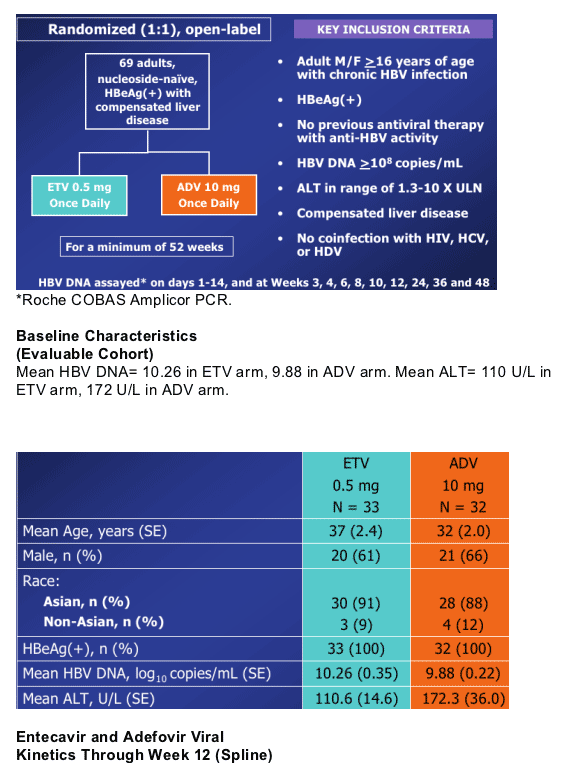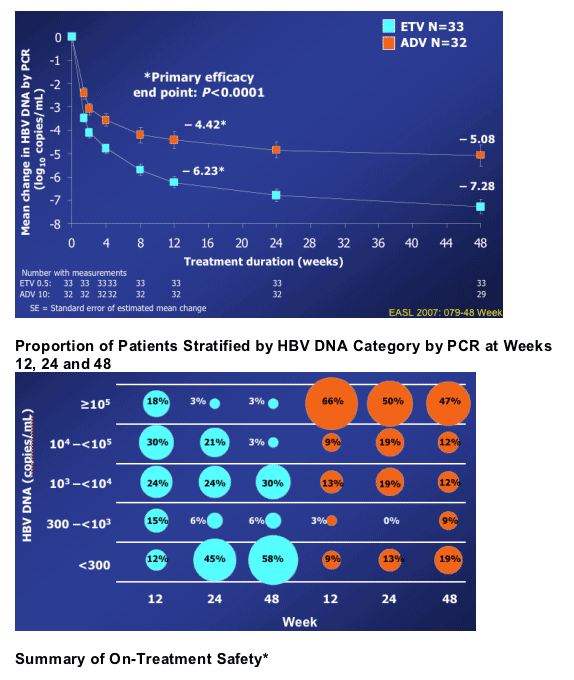 |
 |
 |
| |
Entecavir (ETV) Results in Higher HBV-DNA Reduction vs Adefovir (ADV) in Chronically Infected HBeAg(+) Antiviral-Naive Adults: 48-Wk Results (E.A.R.L.Y. Study)
|
| |
| |
Reported by Jules Levin
42nd EASL (European Association for the Study of the Liver)
April 11-15, 2007, Barcelona
Nancy Leung reported the study results in an oral general session yesterday Friday.
N Leung1, C-Y Peng2, J Sollano3, L Lesmana4, M-F Yuen5, L Jeffers6, H-W Hann7, M Sherman8, U Diva9, K Mencarini9, R Colonno9, A Cross9, R Wilber9, JC Lopez-Talavera9 for the entecavir viral kinetics group
1. Alice Ho Miu Ling Nethersole Hospital, Hong Kong, China; 2. China Medical University Hospital, Taichung, Taiwan; 3. Santo Tomas University Hospital, Manila, Philippines; 4. Cipto Mangunkusumo National Central General Hospital, Jakarta, Indonesia; 5. Queen Mary Hospital, Pok Fu Lam, Hong Kong, China; 6. University of Miami Center for Liver Diseases, Miami, Florida, USA; 7. Liver Disease Prevention Center, Division of Gastroenterology and Hepatology, Thomas Jefferson University Hospital, Philadelphia, USA; 8. Toronto General Hospital, Toronto, Canada; 9. Bristol-Myers Squibb Pharmaceutical Research Institute, Wallingford, CT, USA
BACKGROUND
Elevated HBV DNA is associated with increased risk of disease progression and complications, including HCC, in patients with chronic HBV infection (CHB)1
Antiviral strategies should aim at rapid and extensive reduction of HBV DNA to the lowest levels possible2
ETV is a potent guanosine analogue which has demonstrated superior virologic, histologic, and biochemical efficacy compared to lamivudine in phase 3 studies of patients with CHB3,4
We present a 48-week update from the first direct comparison of the efficacy of ETV vs ADV in antiviral-naive HBeAg(+) CHB patients
1. Chen CJ, et al. JAMA. 2006; 295:65-73.
2. Keefe EB, et al. Clinical Gastroenterology and Hepatology. 2006
Aug;4(8):936-962.
3. Chang TT, et al. N Engl J Med. 2006;354:1001-1010.
4. Lai CL, et al. N Engl J Med. 2006;354:1011-1017.
STUDY OBJECTIVES
Primary
Demonstrate ETV has superior early antiviral efficacy at Week 12
--Measured by mean change in serum HBV DNA levels (PCR log10 copies/mL)
Secondary
HBV kinetics through Week 12
Mean HBV DNA change from baseline through Week 48
Proportions of patients in each treatment group who achieved
-- HBV DNA <300 copies/mL
-- ALT ≦1 X ULN
-- HBeAg loss and HBe seroconversion
Safety
AUTHOR CONCLUSIONS
At Week 48, 58% of ETV-treated patients achieved undetectable HBV DNA levels compared to 19% of ADV treated patients
ETV 0.5 mg was superior to ADV 10 mg for the primary efficacy endpoint of reduction in viral load at Week 12
A significant difference between the treatment arms in favor of ETV was reached as early as Day 10
Difference in mean HBV DNA change from baseline between treatment arms continued to diverge throughout study follow-up
At 48 weeks, 47% of ADV-treated patients had HBV DNA >105 compared to 3% of ETV-treated patients
ETV was safe and well tolerated
STUDY DESIGN
69 nucleoside-naive, HBeAg+ adults with compensated liver disease were randomized 1:1 to Entecavir (ETV) 0.5 mg once daily or Adefovir (ADV) 10 mg once daily for a minimum of 52 weeks. They had to have HBV DNA >10 to the 8th copies/ml. 35 were randomized to ETV: 1 pt lost to follow-up; 1 pt non-compliant so n=33 evaluable cohort. 34 randomized to ADV: 1 pt treated with ETV, 1 pt withdrew so n=32 evaluable ADV cohort,


Mean HBV DNA Change (SE) from
Baseline Through Week 48
The mean HBV DNA reduction at week 12 (primary endpoint) was -4,42 for ADV (n=32) and -6.23 for ETV (n=33) (p<0.0001), and at week 48 the mean HBV DNA reduction is -5.08 for ADV (n=29) & -7.28 for ETV (n=33).


*Safety population is all treated patients according to treatment received (one patient was randomized to ADV but was treated with ETV).
Elevated ALT at Day 28 that resolved on continued study treatment.
One patient experienced elevated ALT on Day 1 that resolved on continued study treatment; one
patient experienced a rib fracture in a motor accident, and one patient had acute hepatitis with ALT
flare.
ALT >2 x baseline and >10 x ULN
|
| |
|
 |
 |
|
|